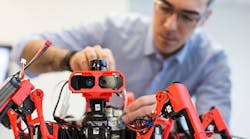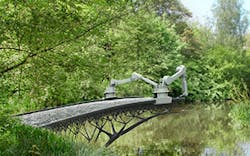Even though you can now fabricate objects out of anything from precious metals to biomaterials with 3D printers, the size of the machine’s build space remains a huge limiter on creativity and engineering prowess remains.
One tactic is to scale up. Cincinnati Incorporated’s Big Area Additive Manufacturing (BAAM) machine is so big (up to 240 x90 x72 in.) it can print a Shelby Cobra. That is dwarfed by the Italy-based company WASP (World’s Advanced Saving Project), which designed has the world’s largest printer.The BigDelta, a towering 12-meter structure that uses local materials, such as clay, to build sustainable habitats, much like those annoying wasps in your garage do.
The biomimicry approach is a stroke of genius, but if you’re looking for the best 3D printing architects in the animal kingdom, it’s not a giant wasp. It’s the spider.
Siemens researchers in Princeton, New Jersey, have developed 8-legged 3D printing robots, called SiSpis, capable of extruding polylactic acid (PLA), a mixture of cornstarch and sugarcane used in some 3D printing applications. It makes perfect sense, as arachnids have been 3D printing for millions of years.
Siemen's SiSpi is capable of extruding PLA right now, and "almost anything in the future, the researchers say.
Photo: Siemens
How could a tiny robot spider prototype beat a giant 3D printer? With quantity of course.
“Each spider is capable of manufacturing only a small portion of a work piece,” explains Hasan Sinan
Bank, one of the project’s leading researchers. “We are therefore trying to conceptualize and optimize the kinds of collaboration these robots should engage in.”
The spider uses an onboard camera and laser scanner to interpret its environment, and then autonomously calculates how much of an object it can handle. Other spiders would then decide which vertical boxes they would cover, using an algorithm developed by Siemen’s Product Design, Modeling and Simulation Research group. This ensures that even when dealing with complex geometries, no area is missed.
“No one else has attempted to do this using mobile manufacturing,” says Bank.
Currently, the batteries last about two hours. When low, the spider returns to its charging station and another spider would pick up where it left off.
The technology is in its early infancy, and PLA is the only substance the spiders employ, but project leader Livio Dalloro says the team is looking into concrete and other materials.
“We are looking at using multiple autonomous robots for collaborative additive manufacturing of structures, such as car bodies, the hulls of ships and airplane fuselages,” Dalloro says.
Unless you have a severe case of arachnophobia, now might be a good time to think about 3D printing’s exciting future outside the box.
“Once the technology becomes mature, it could be applied to almost anything,” Banks says.
What that means to us is several robot spiders, filled with different materials ranging from ABS to metals, swarming a work space to build a car or computer out of thin air.
Now you may still be skeptical about how even a hundred of these spiders would be faster and more efficient than a giant 3D printer for building large structures. That’s fair.
To accomplish such a feat, just get the engineers working on the MX3D's 3D-printed bridge project in Amsterdam with the people who built, La Princesse, the 50-foot high giant performance spider in France. Giant spiders have terrorized our psyches for long enough. It’s about time we start putting them to work, building skyscrapers and moon bases. It might just be worth the night terrors.
MX3D's 3D bridge printer.
Image: MX3D
La Machine's 50-foot tall mecha spider
Photo: flickr/mobilevirgin














